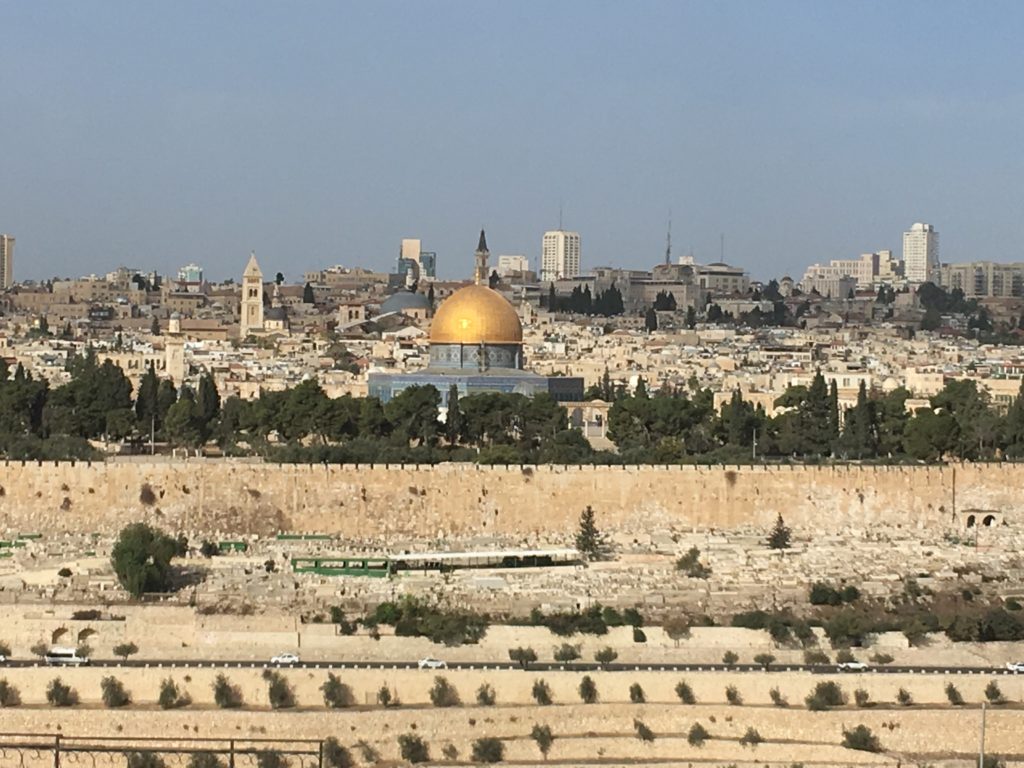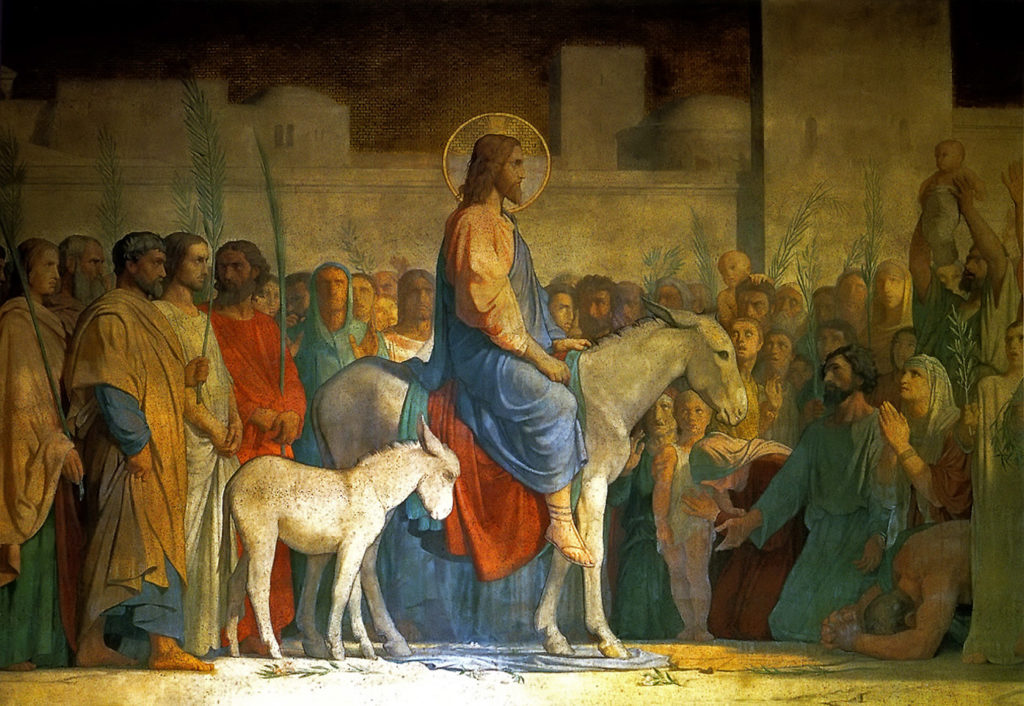SOURCE: Lent 2019, Conference to Santa Clara, CA OCDS, Father Robert Elias Barcelos, OCD
Palm Sunday, often known as Passion Sunday, is the beginning of Holy Week. It is when our Blessed Lord entered into Jerusalem in triumph. It was a foretaste, a prefiguring of His victory of the resurrection. But He knew that the same people who were praising and celebrating Him would turn their backs on Him, totally backstab Him, and cry out, “Crucify him! Crucify him!”
We as the body of Christ who love Jesus, in reading that long gospel on Palm Sunday, and in taking the parts of the people – it hurts us to have to say those words.
During Holy Week, we are called to enter into one, the reality of His Divine Mercy and two – into our responsibility to enter into this grace; recognizing that because of our human woundedness, when we fail in charity and true love for others, as our expression of true love of God -–, we too are subconsciously crying out ‘Crucify him! Crucify him!”
This understanding calls us to conversion, to allow Jesus to give us heart surgery, that He may take out what is not of His Spirit and put in what is. Holy Week is calling us to enter into the holiness of God’s heart as perfectly revealed in Jesus of Nazareth.
It’s so hard for most people, who aren’t brought up in the faith, who don’t yet know Jesus as Lord and God -Man, to recognize that Jesus is more than just a teacher, an important religious figure, a spiritual hero, a holy man, a western version of the Buddha, a prophet – or any representation of Him. He is more than Muhammad; He is more than Elijah.
It takes the grace of the Holy Spirit through the enlightenment of the Father to recognize that Jesus, as Hebrews Chapter 1 says, is the perfect image of God’s divine being, the refulgence of His glory in human form.
Colossians, Chapter 1, says that the whole universe came into existence and being through God’s Beloved Son, His Eternal Word. That revelation recognizes that everything came into being, and received its life through the Divine Word of God’s only-begotten son. In His self-communication, He came in as the second person of the Blessed Trinity and He would become incarnate, taking on the name Yeshua – Yahweh saves; Immanuel -the Divine Reality of God in our midst.
It takes the grace of God to recognize that Jesus is more than just an awesome human being.
When we enter into Holy Week, in order for it to have its full impact, we must come with this understanding as the basis of our faith. But then there’s a second part. We must not only recognize Jesus as Lord, but recognize that He is Lord now, today.

He is present now in the celebration of the sacred mysteries through the Divine Liturgy, through the Sacrament of the Eucharist, through the Mass – Missa – the Mission of God – the communication of God. God is bringing back to life, today, here and now, the reality of who He is and what He did once and for all.
Who He is and what He did in embracing all of us on the
cross and lifting all of us personally through the resurrection – is being made
present, real, and alive again. It is
being given again as if we were Jesus’ contemporaries.
How is this happening? This is the Theology of the Sacraments, the Theology of
Mysticism – the mystery of Christ in our midst.
We’re called to enter into this mystery of God embracing us through
Jesus Christ in the Eucharist.
When we celebrate Passion Sunday, when we celebrate Holy Thursday, the continuation of Jesus’ priesthood through His ministers, the institution of the Blessed Sacrament, His Divine Presence in the Eucharist; when we celebrate Good Friday, His life-giving death – that death may not be the end of the story, but the transition of our story to our total destiny; when we celebrate the Resurrection of Jesus, especially during the Easter Vigil, when it is celebrated with reverence – all of these aspects of the Liturgy is Jesus bringing back to life again, the most sacred mystery that ever happened on this planet.
God wants that most sacred gift of Himself to be our possession. He wants to possess us through the Holy Spirit.
The Theology of the Sacraments teaches that God’s sacred gift happens, not in a physical or literal way. Jesus isn’t suffering or being crucified again. The spiritual significance of what he did, is being given to us, through the grace of the Holy Spirit by way of signs – every thing that we use physically and materially to express the mystery.
For instance, in the sacrament of Baptism we use water; in the Eucharist, we use bread and wine, at the Easter Vigil, we use candles; we have chrism oils. All of these are signs that point to the perfect reality that God is giving Himself to us and through these signs, God gives us the actual grace – the Holy Spirit. He manifests Himself.
Baptism is such a simple sacrament. The ideal method is immersion, because it expresses our immersion into the life of God. But even with just the sprinkling of a few drops of water, the same reality happens. It is totally invisible to our senses. We don’t see the transformation, but in the essence of that person’s soul, a metamorphosis takes place. The Word is made flesh. Through faith, we receive this grace, though our senses don’t perceive it.
Another understanding of entering Holy Week to worship God in spirit and in truth is that we receive from the Liturgy what we put in it through faith. In the measure that we have an understanding and knowledge of what is happening intellectually or intuitively, our heart’s faith is fueled to enter into the mystery that we may allow ourselves to be loved by Jesus here and now.
The measure of our understanding allows Him to take possession of our lives, and to have His mystery be enfleshed in our lives; it allows His cross and resurrection to transform our lives in the way that the cross is already present.

How is the cross present in your life?
It is already there. You don’t’ have to look for one. It’s in your son who doesn’t go to church, who gives you a hard time, and pushes you to witness to your faith by your actions rather than by your words – more than by your nagging him to go to Church. It’s in your daughter who is sick with illness like cancer. It’s in your husband who, when you get home, is just asleep on the couch; but your dog gives you more joy than your husband does!
It’s there in countless ways when your heart, which is made for love, is disappointed.
It’s there in every way that your love is challenged. It’s there every way you experience your own brokenness and limitation and inability to love with freedom. The cross is everywhere.
The question is, what do we do with it?
Do we dismiss it as an inconvenience and a contradiction? As a nuisance and a curse? Or do we embrace it and accept it as a blessing in disguise? Do we accept it as the wisdom and power of God? As a promise to something better, as a potential that can teach us something and ignite passion in our hearts?
The cross is already there.
How we embrace the cross will make the difference in how beautiful our crown will be. You can have a little itty-bitty crown – if you want a little cross. If you want a big crown, you need a big cross. Simple as that. The bigger your cross, the bigger your crown.
The more you concretely participate in the sacrifice of Jesus through your choices, the more you will share in His victorious glory. The choice is ours. May He strengthen us to have courage. May he strengthen us to have the faith to persevere. May he strengthen us to become saints.
